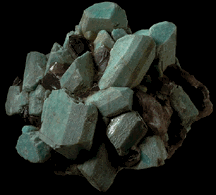
LAB 2
Minerals
Crystals of green K-feldspar and quartz, Pikes Peak, Colorado
|
|
LAB 2 Minerals |
|
Crystals of green K-feldspar and quartz, Pikes Peak, Colorado |
Objectives:
The solid earth (the lithosphere) is composed of minerals. Minerals are vital as natural resources, are active in geological processes associated with earthquakes and volcanoes, provide clue to how rocks are formed, and record the history of our planet. In this lab, we become familiar with the most common minerals. We learn to identify them based on their physical properties (see below) and relate them to the formation of igneous rocks. To complete this lab you will perform some simple tests and make your own observations.What is a mineral?
To be considered a mineral, a substance must possess the following five characteristics:1. naturally occurring (not made in the laboratory)
2. inorganic (not living material)
3. solid
4. a crystal structure defined by an orderly arrangement of its atoms
5. a definite chemical composition that only varies within specified limits
Reading:
Skinner, Porter & Botkin, The Blue Planet Chap. 6: p.119-123.Useful web site:
Mineralogical Society of America
www.minsocam.org/
Physical properties of minerals:
COLOR: Color is the easiest property to identify. However, color is the most deceptive property. Color results both from a mineral’s chemical composition, and from the interaction of light with the mineral’s internal structure. Many minerals display a wide range of colors. Color can be useful in distinguishing the elemental composition of a mineral. For example, a mineral displaying a rusty red color may contains oxidized iron.
STREAK: Streak is the color a mineral produces when ground into a fine powder. The streak color is much better for mineral identification than a mineral’s visible color because the streak is characteristic whereas color may be variable.
HARDNESS: Hardness is a mineral's ability to resist or inflict abrasion (a scratch) on a reference material. Hardness is directly related to the strength of the chemical bonds in a mineral. Hardness is given as a number from 1 through 10, where 1 is the softest and 10 is the hardest.
SPECIFIC GRAVITY: Specific gravity is related to density, or how much a mineral weighs compared to its volume. Specific gravity is measured relative to pure water, which has a reference density of 1. We will describe the specific gravity of minerals in this lab as high, medium, or low. For example, if you pick up, or heft, a mineral and it "feels light" for its size, then that mineral has a low specific gravity. Most minerals have medium specific gravity; in other words, when you pick them up they are about as heavy as you would expect (based on your prior experience of throwing rocks in a pond!).
MAGNETISM: Magnetism is the ability of some minerals to behave like a magnet, particularly those that contain a large amount of iron. This natural magnetism in crystalline minerals is not to be confused with the Earth's magnetic field generated in Fe-rich alloys of the liquid outer core.
LUSTER: Luster is a description of how a mineral reflects light. For this lab we will describe minerals as either metallic (looks like polished metal) or non-metallic (does not look like a metal, but is reflective and may appear shiny, glassy, greasy, waxy, or resinous). Many minerals have no luster, and are described as dull or earthy (not to be confused with geologists).
CLEAVAGE: Cleavage is a description of the way minerals break along certain planes of weakness in their chemical structure. A mineral has cleavage if it breaks to form flat surfaces, defined edges, and angular corners. Because cleavage planes are flat and smooth, they are generally reflective; therefore, you can see cleavage surfaces by holding a mineral up to the light to see if the light flashes off flat surfaces.
CONCHOIDAL FRACTURE: Fracture is another way to describe the way a mineral breaks. Fracture is different from cleavage because minerals that break by fracturing do not form regular surfaces and edges. The fractures may form in any orientation, and they are commonly curved. Minerals that exhibit conchoidal fracture often appear glassy.
STRIATIONS AND EXSOLUTION LAMELLAE: Striations are parallel lines on a mineral’s cleavage surfaces that look like tiny hairline grooves (like on an LP or CD). Striations are used to distinguish plagioclase feldspar which has striations from potassium feldspar which does not. Striations appear when the mineral’s cleavage surface reflects the light–best seen when holding a mineral up to the light and catching a reflection off a cleavage surface. Potassium feldspar (also orthoclase feldspar or K-spar) exhibits bands of different color on cleavage surfaces. These bands, or exsolution lamellae, are planar zones of slightly different composition.